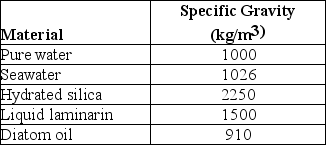Multiple Choice
Use the following description and table to answer the question.
Diatoms are encased in petri-plate-like cases (valves) made of translucent hydrated silica whose thickness can be varied. The material used to store excess calories can also be varied. At certain times, diatoms store excess calories in the form of the liquid polysaccharide, laminarin, and at other times as oil. The following are data concerning the density (specific gravity) of various components of diatoms, and of their environment.
Specific Gravities of Materials Relevant to Diatoms
Water's density and, consequently, its buoyancy decrease at warmer temperatures. Based on this consideration, and using data from the table above, at which time of year should one expect diatoms to be storing excess calories mostly as oil?
A) mid-winter
B) early spring
C) late summer
D) late fall
Correct Answer:

Verified
Correct Answer:
Verified
Q16: Trypanosome infections evade attacks by host immune
Q23: You are given an unknown organism to
Q23: According to the phylogeny presented in this
Q24: In order to determine the "root" of
Q25: Green algae differ from land plants in
Q26: Use the following figure to answer the
Q27: You are given four test tubes, each
Q31: You are given four test tubes, each
Q32: Use the following description and table to
Q33: Consider the following data:<br>(a) Most ancient eukaryotes